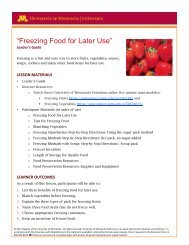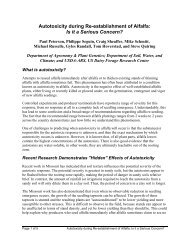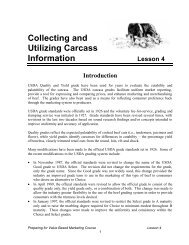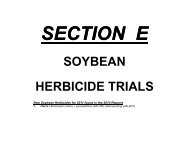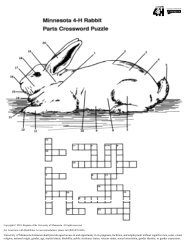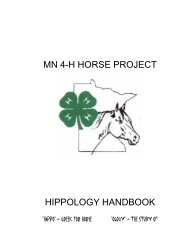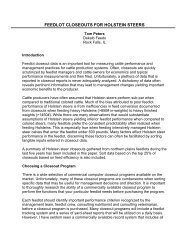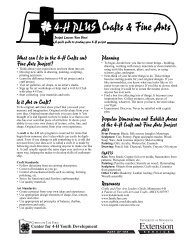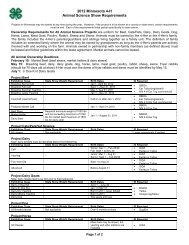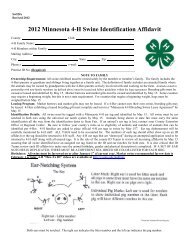Establishing Custom Calf and Heifer Raising Contracts
Establishing Custom Calf and Heifer Raising Contracts
Establishing Custom Calf and Heifer Raising Contracts
Create successful ePaper yourself
Turn your PDF publications into a flip-book with our unique Google optimized e-Paper software.
www.extension.umn.edu<br />
<strong>Establishing</strong> <strong>Custom</strong> <strong>Calf</strong> <strong>and</strong><br />
<strong>Heifer</strong> <strong>Raising</strong> <strong>Contracts</strong><br />
Hugh Chester-Jones, Ph.D., P.A.S.<br />
Introduction<br />
Copyright © 2007 Regents of the University of Minnesota. All rights reserved.<br />
The custom calf <strong>and</strong> heifer raising business is very prevalent in the dairy industry across<br />
the country. Early-on in the development of the nationwide custom raising business,<br />
contractual agreements often were based on verbal trust. As with any dairy farm<br />
operation, the dynamics of livestock systems present unforeseen daily challenges. A<br />
written agreement between the dairy producer client <strong>and</strong> the calf or heifer raiser is critical<br />
to meet the goals of both enterprises. A contract provides a consistent document that<br />
describes key responsibilities.<br />
This paper will outline a process adopted by the University of Minnesota Southern<br />
Research <strong>and</strong> Outreach Center (SROC) staff to set-up contractual agreements with three<br />
commercial dairy operations for raising wet calves from 2 to 200-days of age. Example<br />
contracts are shown with options to consider. (for educational purposes only). These are<br />
templates that can be used as a base <strong>and</strong> are not intended as official legal documents.<br />
Other information will be available in these conference proceedings on custom heifer<br />
raising fundamentals. Selected internet resources are listed at the end of this paper.<br />
SROC Contract Process - Good Communications at all times is the key to success of<br />
establishing trust <strong>and</strong> an agreeable contract. The initial task was to identify the custom<br />
raising niche that best fit into available resources (facilities, feed, labor, management <strong>and</strong><br />
industry demographics etc). Are there any facility upgrading, new barns or equipment<br />
needed to function more effectively as a custom raiser?<br />
In the case of SROC, new facilities to accommodate suitable calf numbers were a<br />
necessity. A cash flow budget was prepared to indicate how many calves/heifers it will<br />
take to cover costs <strong>and</strong> provide a margin back to the operation infrastructure. How many<br />
<strong>and</strong> what sized dairies need to be included to meet cash <strong>and</strong> animal flow objectives?<br />
Dairy client-custom raiser meetings - Locating interested dairies was the next step in<br />
the process of building to optimum capacity. The transition period to secure sufficient<br />
numbers may take a few months. Once the business is under way <strong>and</strong> the calves or<br />
heifers do well then this will establish creditability. The first meeting by SROC staff<br />
with the initial dairy client was at the SROC facilities whereby the dairy owner <strong>and</strong> his<br />
manager could walk through the facilities <strong>and</strong> underst<strong>and</strong> the management. The second<br />
face to face meeting at the dairy operation included the veterinarian, dairy farm personnel<br />
<strong>and</strong> SROC staff. The next phase grower (s) was an important participant in subsequent<br />
meetings. For a second dairy client, the first discussions were arranged at a neutral site, a<br />
1
local restaurant, together with the second phase grower to underst<strong>and</strong> the perspective <strong>and</strong><br />
needs of each party.<br />
During subsequent meetings specific responsibilities by the dairy owner <strong>and</strong> custom<br />
raiser were clearly established. . In the case of the SROC operation the dairies retained<br />
ownership. A suggested daily charge was proposed. Discussions ensued on payment<br />
plans, pick-up <strong>and</strong> delivery responsibilities, health programs, death loss, <strong>and</strong> growth<br />
goals. Maintaining good records <strong>and</strong> being able to monitor periodic growth of the cattle<br />
were important criteria. It was proposed that st<strong>and</strong>ard procedures be laminated <strong>and</strong> posted<br />
in the barns with contact phone numbers as needed. Two of the three dairies required<br />
SROC to take calves as soon as possible prior to completion of the new barns <strong>and</strong> as such<br />
existing facilities (inside calf room, calf hutches , calf condo) <strong>and</strong> temporary renovation<br />
of an old sow-boar gestation barn were used until the new calf <strong>and</strong> heifer grower barns<br />
were operational. An existing manure-pack pole barn would remain as an integral part of<br />
the post weaned heifer group pens. A third dairy client met at SROC <strong>and</strong> agreed to work<br />
with SROC once the new barns were in service.<br />
An example of an annual contract for the SROC dairy clients is shown in Sample<br />
Template 1 below. This contract was agreed upon by all parties <strong>and</strong> the final draft<br />
reviewed by lawyers for legality. The contract does include sentences that are unique to<br />
Universities but for the most part does represent typical commercial applications. The<br />
contract is working well to date with continuous input from all parties for areas of<br />
improvement. Sample Templates 2,3, <strong>and</strong> 4 below provide varying approaches to writing<br />
contracts <strong>and</strong> responsibilities.<br />
Much of the process at SROC is learning how to manage the new facilities to<br />
accommodate fluctuating calf numbers <strong>and</strong> changing weather patterns. Health programs<br />
may differ between dairies. Any health program changes should be outlined <strong>and</strong><br />
discussed before being implemented. If the quality of calves or heifers to be raised<br />
appears to be lower than expected at the initial pick-up, then this must be addressed<br />
immediately. Alternatively if heifers due to move to a second phase grower do not meet<br />
expectations similar action should be implemented.<br />
Sample Template 1<br />
THIS SERVICES AGREEMENT (the “Agreement”) is entered into effective as<br />
of June 1, 2003, by <strong>and</strong> between the Regents of the University of Minnesota (the<br />
"University" also referred to as “<strong>Calf</strong> Raiser”), a Minnesota constitutional corporation,<br />
<strong>and</strong> Bombay Dairy Co. (the “Company” also referred to as “Owners”), a corporation.<br />
This agreement is entered into by the University through its Southern Research <strong>and</strong><br />
Outreach Center (SROC), Waseca.<br />
NOW, THEREFORE, the parties agree as follows:<br />
2
Description of Services. The University shall render the following services (reference to<br />
services in this Agreement shall be deemed to include any deliverables):<br />
OWNERS RESPONSIBILITIES: The Owners agree to supply healthy calves to be<br />
picked up by the <strong>Calf</strong> Raiser once or twice weekly as per verbal communication between<br />
respective Parties. Prior to pick-up all calves will have received at least 3 feedings of high<br />
quality colostrum, navel dipped twice, ear tagged <strong>and</strong> administered an agreed health<br />
program protocol. Unthrifty calves will be not sent to the <strong>Calf</strong> Raiser.<br />
All health costs prior to pick-up will be the Owners responsibility. The Owners will<br />
assume the financial consequences of death loss of calves up to 5% of calves delivered to<br />
the <strong>Calf</strong> Raiser for the duration of the raising period. The calf raiser shall reimburse the<br />
owners for any death loss over 5% at a rate of $xxx.xx per calf. Kenyon Farms or other<br />
grower identified by Owner, will be responsible for payment on all healthy calves from<br />
170 to 200 days of-age to the equivalent rate of $x.xx/day. The total amount due to<br />
SROC will be paid at the time of pick-up from SROC by Kenyon Farms or other grower.<br />
Appropriate adjustments will be made by SROC to cover costs for transporting calves by<br />
the next stage grower. In the event of non-payment from Kenyon Farms, the Owners<br />
will assume responsibility <strong>and</strong> guarantee payment to the <strong>Calf</strong> Raiser. In the event that a<br />
calf is not suitable for delivery to Kenyon Farms, the calf will be sold. Proceeds above<br />
the <strong>Calf</strong> Raiser’s input costs will be distributed to the Owners.<br />
The Owners agree to allow calves to be used for nutrition research studies by the <strong>Calf</strong><br />
Raiser as long as Growth Rate <strong>and</strong> Health Goals are not compromised. The Owners will<br />
retain ownership of all calves throughout the calf raising contract period.<br />
Sample Template 1 (cont’d)<br />
CALF RAISER RESPONSIBILITIES: The <strong>Calf</strong> Raiser agrees to pick-up healthy<br />
calves once or twice weekly from the Owner as per verbal communication between<br />
respective Parties. The <strong>Calf</strong> Raiser agrees to cover transport costs incurred for pickingup<br />
calves <strong>and</strong> also delivery of 170 to 200 day-old calves to the second stage grower. The<br />
health status of calves will be determined at time of pick-up. The <strong>Calf</strong> Raiser will<br />
administer a health program <strong>and</strong> sanitation protocol that has been agreed upon by<br />
respective Parties from the day of pick-up to completion of the 170 to 200 day period. A<br />
minimum of two modified live bovine respiratory complex <strong>and</strong> 2 clostridial vaccines will<br />
be administered. All health incidences <strong>and</strong> treatments will be documented.<br />
The <strong>Calf</strong> Raiser will confirm colostrum immunity transfer within 24 hours of pick-up<br />
based on serum protein concentrations determined by a refractometer. Additional checks<br />
for the presence of calf pathogens in the blood, feces, or tissue will be agreed upon by the<br />
respective Parties. The <strong>Calf</strong> Raiser agrees to assume all costs incurred for death loss<br />
rates of > 5% of calves delivered during the duration of the raising period. The <strong>Calf</strong><br />
Raiser agrees to cover all health costs incurred during the contract period after pick-up.<br />
The <strong>Calf</strong> Raiser will not use a Brucellosis vaccine in the heifer calves. The <strong>Calf</strong><br />
3
Raiser agrees to implement all routine conditioning programs including de-horning,<br />
removing of extra mammary teats, <strong>and</strong> tail docking. Periodic re-evaluation of the health<br />
protocol will occur bi-monthly between respective Parties. The <strong>Calf</strong> Raiser is the<br />
custom feeder of all calves throughout the contract period. The Owners will retain<br />
ownership of all calves picked-up by the <strong>Calf</strong> Raiser.<br />
The <strong>Calf</strong> Raiser will implement high quality liquid <strong>and</strong> dry feeding programs to ensure a<br />
minimum average growth rate of between 1.6 <strong>and</strong> 1.7 lbs daily, wither height <strong>and</strong> body<br />
weight within the range of 40-41 inches <strong>and</strong> 370-410 lbs, respectively, prior to calves<br />
being delivered to the second stage grower. Periodic body weights <strong>and</strong> skeletal<br />
measurements will be taken throughout the calf raising period.<br />
Compensation. For the services rendered under section 1, the Company shall pay the<br />
University as stated above.<br />
The compensation shall be paid: (Check one of the two boxes)<br />
in full upon the signing of this Agreement; or<br />
X in full, payable on a monthly basis – on stock delivered in the<br />
preceding month.<br />
Term. The term of this Agreement shall commence on: (Check one of the two boxes)<br />
the date first above written; or<br />
X on July 1, 2003<br />
Sample Template 1 (cont’d)<br />
The term of this Agreement shall expire on June 30, 2004, unless terminated<br />
earlier as provided.<br />
Termination. Either party may terminate this Agreement for material breach on seven<br />
(7) days’ written notice, during which period the breaching party may cure. Additionally,<br />
either party may terminate this Agreement for its convenience upon ninety (90) days’<br />
prior written notice to the other party. Upon termination, the Company shall promptly<br />
pay the University for all services rendered <strong>and</strong> costs incurred up to <strong>and</strong> including the<br />
effective date of termination.<br />
Unless more specific insurance provisions are attached, the following shall apply:<br />
At all times during its performance under this Agreement, the Company shall obtain <strong>and</strong><br />
keep in force comprehensive general liability insurance, including coverage for death,<br />
bodily or personal injury, <strong>and</strong> property damage, including products liability, with limits<br />
of not less than $500,000 each claim <strong>and</strong> $1,000,000 each occurrence. All such<br />
certificates evidencing such insurance shall name the Regents of the University of<br />
Minnesota as an additional insured. The Company represents that it has workers’<br />
4
compensation insurance to the extent required by law. The Company agrees to furnish<br />
proof of all such insurance to the University upon request.<br />
IN WITNESS WHEREOF, the parties have entered into the Agreement as of the date<br />
first above written.________________________________________________________<br />
Sample Template 2<br />
This agreement, dated the __________ day of _______________, 20_____ made<br />
between Drewry Farms, Inc of xxxx WI, <strong>and</strong> Farm Representatives, hereinafter referred<br />
to as “CONTRACTOR”, <strong>and</strong> (name)<br />
_____________________________________________________<br />
of (address)_________________________________________________hereinafter<br />
referred to as “OWNER”.<br />
The CONTRACTOR agrees to house, feed, breed, <strong>and</strong> provide ordinary care for the<br />
OWNER’S heifers from the time of acceptance at ________ months of age until the<br />
heifer reaches ________ months pre-fresh for the agreed price of ________ per day. Any<br />
change in the per day price must be done in writing, 120 days in advance of said price<br />
change.<br />
TIME OF ACCEPTANCE<br />
1-Calves will be picked up by the CONTRACTOR on the first Monday of the month.<br />
Sample Template 2 (cont’d)<br />
2-Calves should be approximately 34” tall <strong>and</strong> 2 months of age; from cold housing, such<br />
as hutches; dehorned; eating a grain feed; <strong>and</strong> in good condition.<br />
3-OWNER must vaccinate their calves anytime between birth <strong>and</strong> at least 48 hours prior<br />
to departure with Intranasal vaccine.<br />
4-OWNER must vaccinate their calves with a clostridium vaccine before arrival.<br />
5-Animals will be ear tagged with at least a two-inch tag in the left ear with a visible ID<br />
number.<br />
6-OWNER will provide CONTRACTOR with birth date, past medical record, <strong>and</strong> any<br />
other information deemed necessary by the CONTRACTOR.<br />
7-OWNER must verify annual milk herd vaccination program <strong>and</strong> that calf has been fed<br />
adequate colostrum.<br />
8-CONTRACTOR will photograph each calf <strong>and</strong> keep such photos in a file to reduce<br />
any confusion of calf identification.<br />
9-CONTRACTOR reserves the right to reject any calf.<br />
10-If calves arrive not being dehorned, vaccinated, tagged, etc., owner will be charged<br />
the cost of having these things done.<br />
5
TRUCKING<br />
<strong>Heifer</strong>s will be picked up <strong>and</strong> delivered to the OWNER on the first Monday of the<br />
month. Any other arrangements MUST be made in advance. <strong>Heifer</strong>s will be delivered 2<br />
months prefresh according to pregnancy checking by veterinarian, unless other<br />
arrangements are made prior to delivery.<br />
VETERINARIAN COSTS<br />
CONTRACTOR will provide ordinary veterinarian costs for calves to be vaccinated,<br />
dewormed, feet trimmed, removal of extra teats, <strong>and</strong> pregnancy checked.<br />
CONTRACTOR agrees to give the following vaccines:<br />
1-BoviShield 4 + L5 <strong>and</strong> Brucellosis given between 4-8 months of age.<br />
2-BoviShield 4 + L5 given 3-4 weeks before breeding.<br />
OWNER will be consulted when there is other veterinarian work to be performed on his<br />
animals <strong>and</strong> a course of action will be decided on by both the OWNER <strong>and</strong><br />
CONTRACTOR. Subsequent treatment is paid by the OWNER.<br />
BREEDING<br />
<strong>Heifer</strong>s will be bred when they reach approximately 50 inches in height unless other<br />
arrangements have been made at the time of acceptance by the CONTRACTOR.<br />
Sample Template 2 (cont’d)<br />
1-CONTRACTOR will do all the heat detection at the CONTRACTOR’S discretion.<br />
2-Calving ease bulls with semen valued at $10-$20 per straw will be used. Semen<br />
requests above that amount will be charged to the OWNER.<br />
3-OWNER may select semen or designate OPERATOR or breeding technician to do the<br />
same.<br />
4-OWNER may have his heifers synchronized to be bred at the same time <strong>and</strong> is<br />
responsible for the costs of the drugs used.<br />
5-CONTRACTOR will be responsible for having heifers pregnancy checked at about 40<br />
days following last breeding.<br />
6-OWNER <strong>and</strong> CONTRACTOR will decide what to do with heifers bred more than<br />
two times <strong>and</strong> still not pregnant.<br />
7-Any other breeding services, i.e., ET work, may be done upon agreement between<br />
OWNER <strong>and</strong> CONTRACTOR.<br />
BILLING<br />
6
OWNERS will be billed on the 1 st of each month <strong>and</strong> payment in full, is due by 15 th of<br />
that month. Bills not paid in full at that time will be assessed a service charge of 1.5%<br />
after 30 days or a rate of 18% per year. The OWNER underst<strong>and</strong>s that Wisconsin<br />
Statutes SS 779.43 (3) provides for a lien by CONTRACTOR on those animals until<br />
OWNER pays for the cost of such housing <strong>and</strong> feed expenses.<br />
LIMITATION OF LIABILITY<br />
The CONTRACTOR’S liability for any act or omission of CONTRACTOR is limited<br />
to the cost of the feed <strong>and</strong> housing of the animal while in the CONTRACTOR’S care.<br />
OWNER is responsible for insurance protection of his cattle.<br />
OWNER always has the right to inspect his animals at any time he feels necessary.<br />
Calling ahead to make an appointment is recommended <strong>and</strong> appreciated.<br />
This agreement shall be binding on, <strong>and</strong> inure to the benefit of, the parties <strong>and</strong> their heirs,<br />
successors or assignees.<br />
Owner<br />
Date<br />
Contractor<br />
Date<br />
Sample Template 3<br />
<strong>Custom</strong> Feeding Contract -- <strong>Heifer</strong>s from 300 lb body weight<br />
I PARTIES<br />
This contract is between ,<br />
Name<br />
hereinafter known as Owner, <strong>and</strong> ,<br />
Name<br />
Address<br />
Address<br />
II OWNER’S RESPONSIBILITIES<br />
• Delivery to <strong>and</strong> from custom feeder at owner’s expense.<br />
• Provide <strong>and</strong> pay for feed supplements to feeder’s home base with the intended<br />
feeding instructions (i.e., feed at 3 lbs/hd./day).<br />
• Veterinary <strong>and</strong> drug costs to be shared equally by owner <strong>and</strong> custom feeder for health<br />
issues while on feed <strong>and</strong> pasture. Vaccinations <strong>and</strong> routine cost related to dairy herd<br />
health, sleeving, dehorning, deteating, <strong>and</strong> etc. to be paid by owner. However, no<br />
veterinary services are to be performed without owner’s or owner’s agent’s<br />
permission <strong>and</strong> by his guidelines.<br />
Owner will assume first one <strong>and</strong> one-half percent of death loss, <strong>and</strong> owner <strong>and</strong> custom<br />
feeder will share death loss thereafter, <strong>and</strong> share <strong>and</strong> share alike, (this value is the<br />
7
assessed in value of $x.xx per lb of in weight per head) except for losses caused by<br />
custom feeder’s negligence, including electrical short, equipment injury (whether<br />
equipment is maintained properly or not). Any death loss, caused by direct action of<br />
custom feeder, will be custom feeder’s responsibility, <strong>and</strong> shall be his loss alone. Direct<br />
actions include such actions as machinery injury, (running over, impaling, crushing, etc.)<br />
poisoning by pesticide, shooting, etc. Insured claims <strong>and</strong> payments will be distributed<br />
back to owner’s assessed value as stated at the above line <strong>and</strong> then balance to the custom<br />
feeder’s value. Insurance will be noted below. Example: Cattle arrive on farm <strong>and</strong><br />
covered by feeder’s insurance, 30 days later lightning strikes one calf. Insurance claim<br />
will pay owner his assessed value <strong>and</strong> the remaining will pay the bid rate of $_____ x.xx<br />
___ per head per day. Veterinarian determines responsibility.<br />
III<br />
CUSTOM FEEDER’S RESPONSIBILITIES<br />
<strong>Custom</strong> feeder will maintain liability insurance on cattle to protect himself against<br />
damages <strong>and</strong> lawsuits. He will care for the cattle with proper <strong>and</strong> good animal husb<strong>and</strong>ry<br />
<strong>and</strong> feed them provided supplement so as to try to maintain approximately 1.7 lb/day gain<br />
in body weight, resulting in a heifer weighing at least 1100 lbs at five months pregnant<br />
<strong>and</strong> 1200 lbs at seven months pregnant. Rations to be fed shall include corn silage, hay or<br />
haylage, balage (primary winter feed) grain, grass (mig or top quality), free choice salt<br />
<strong>and</strong> mineral.<br />
Sample Template 3 (cont’d)<br />
He will prevent direct or indirect harm to the cattle from any source, <strong>and</strong> he will assume<br />
total liability for personal injury caused him by the cattle.<br />
<strong>Custom</strong> feeder will furnish adequate <strong>and</strong> proper housing, yardage <strong>and</strong> bunk feeder space,<br />
<strong>and</strong> will notify owner or owner’s agent at once, if sickness or injury is suspected.<br />
Owner’s cattle shall be housed <strong>and</strong> fed separate <strong>and</strong> cannot be co-mingled with other<br />
cattle or any other animals, unless agreed upon in advance.<br />
IV<br />
FEEDER’S RIGHTS OF MANAGEMENT<br />
In case of bull breeding, feeder has the right to declare a bull unsafe for himself or others<br />
<strong>and</strong> notify the agent that a replacement may be needed. The owner <strong>and</strong> his agent will then<br />
decide course of action.<br />
Feeder has the right to choose the proper mineral <strong>and</strong> supplements to do the required<br />
gain per HD/day level of production. Feeder will use provided minerals <strong>and</strong> or extra<br />
supplements to boost certain areas of nutrition needs.<br />
8
Backgrounder reserves the right to move cattle to pastures other than what is considered<br />
his home base. Cost of shipping cattle will be based on home yards, extra cost due to<br />
further distance will be paid by backgrounder.<br />
Feeder needs to make judgment calls on chronic sick cattle <strong>and</strong> notify the agent or owner<br />
(chronic bloaters, lungers, infected horn bases that are untreatable, etc.). These cattle<br />
need to move off of farm as noted <strong>and</strong> be called unfit breeding stock. This will not go<br />
against death loss <strong>and</strong> goods <strong>and</strong> services need to be settled for the rates of $x.xx per day<br />
to breeding time <strong>and</strong> $x.xx per day after breeding. Breeding date is when mating occurs<br />
through AI or bull in dates.<br />
V<br />
PAYMENT PROVISIONS<br />
Owner agrees to pay custom feeder $ x.xx per day for each animal in custom feeder’s<br />
care, payment to made by day 5 of the following month of entry <strong>and</strong> by day 5 of each<br />
month thereafter. This payment will be for what is called “goods <strong>and</strong> services provided”.<br />
Any load outs will be settled according to contract payments before leaving farm.<br />
<strong>Custom</strong> Feeder has a first lien for the goods <strong>and</strong> services provided under this contract.<br />
Owner agrees to subordinate or obtain subordination from any party having any security<br />
interest in the property to allow the feeder lien to have first priority <strong>and</strong> the feeder lien<br />
protection by the Iowa code Chapter 579.<br />
Sample Template 3 (cont’d)<br />
If AI services are required, the owner will pay the feeder the going AI tech rates <strong>and</strong> cost<br />
of semen <strong>and</strong> related AI services as agreed upon prior to breeding start. Bulls for<br />
breeding shall be provided by owner or agent. The daily rate to be a reflection of market<br />
prices of feed ration ingredients, <strong>and</strong> may be changed only by agreement of both parties<br />
to the contract.<br />
VI<br />
TERMINATION<br />
This contract may be terminated following a thirty-day written notice by either party to<br />
the other. This termination period is to start no sooner than 60 days from the beginning of<br />
the contract unless one of the above-stated requirements are not met.<br />
As stated at beginning, this contract runs to XXX, x, 20xx, if both parties agree it can<br />
continue at this rate under a new contract. At the present time a bid rate of $x.xx per head<br />
per day will be required beyond Oct. 1, 20xx unless preceded by a new contract.<br />
Any disputes will be discussed <strong>and</strong> decided promptly with the addition of a third party.<br />
The area extension dairy specialist Xxxx xxxx based at (your county, (city), (state) will<br />
9
e designated as that third party. If not available, this contract will use next closest dairy<br />
specialist suggested by the Extension Service (Xxx xxx xxxxx).<br />
<strong>Custom</strong> feeder Date Owner Date<br />
Signed:<br />
Address<br />
Address<br />
Sample Template 4<br />
Cattle Care Contract Identification:<br />
This contract is made between John Everett of xxxx WI <strong>and</strong><br />
_______________________________________________,address:_________________<br />
______ phone: ______________on (date) ________ <strong>and</strong> is for the purpose of custom<br />
housing <strong>and</strong> feeding of cattle.<br />
Entrance Requirements:<br />
John Everett retains the right to accept or reject cattle that do not meet the following<br />
specifications:<br />
1) Only healthy, disease-free cattle will be accepted.<br />
2) All heifers must be vaccinated for Brucellosis.<br />
3) All heifers must be vaccinated with a live 9 way vaccine.<br />
4) _____________________________<br />
Sample Template 4 (cont’d)<br />
<strong>Heifer</strong>s in good health will be delivered at age _____, weighing ________ lbs <strong>and</strong><br />
measuring _____ inches at the withers. The owner will pick up the animals _________.<br />
The goal of John Everett is to develop heifers that are bred to calve at 24 months, will<br />
weigh between 1,300-1,350 pounds, are approximately 54 inches at the shoulder <strong>and</strong><br />
have a body condition score of 3.2-3.5 (0-5 point system).<br />
Special Arrangements <strong>and</strong>/or Conditions:<br />
Animal Care, Animal Health <strong>and</strong> Death Loss:<br />
John Everett will provide the feed (minerals, salt, grain, haylage, silage, dry hay),<br />
vaccinations, worming, breeding, pregnancy checks, <strong>and</strong> other veterinary costs, bedding,<br />
dehorning, housing, labor, <strong>and</strong> daily observation.<br />
The owner will be responsible for veterinary costs of preexisting conditions, vaccines,<br />
worm medicines, semen, <strong>and</strong> proper ear tagging, <strong>and</strong> insurance.<br />
Trucking to <strong>and</strong> from the facility will be provided by: ____________________________.<br />
10
A death loss of between 0% <strong>and</strong> 2% on heifers older than weaning age will be considered<br />
normal, with the owner assuming the loss. On calves up to weaning age a death loss of<br />
0%-5% will be considered normal with the owner assuming the loss. Losses in excess of<br />
normal will be split 50/50 based on fair market value. Fair market value will be<br />
determined by xxx<br />
Terms:<br />
Financial terms of this contract are $________ a head per day, billed on a monthly basis,<br />
payable within 10 days. This contract is to be renewed on an annual basis on October 1,<br />
of each year, starting xxxx<br />
A 5-day notice is to be given for the purpose of taking cattle out on the part of the owner.<br />
John Everett will provide a 30-day notice if the owner is requested to remove his cattle,<br />
except in cases of illness.<br />
Owner<br />
<strong>Custom</strong> Feeder<br />
Date<br />
Date<br />
Sample Template 5<br />
THIS AGREEMENT, made <strong>and</strong> entered into this ________ day of ____________,<br />
20____, by <strong>and</strong> between MOHORIC AND MILLER, INC., a Washington Corporation,<br />
hereinafter referred to as “Company”, <strong>and</strong><br />
_________________________________________, hereinafter referred to as “Owner”,<br />
W I T N E S S E T H:<br />
For valuable consideration, the sufficiency of which is hereby acknowledged, the<br />
parties hereto agree as follows:<br />
1. Owner shall place ________ head of replacement heifers with Company for<br />
the purpose of Company providing Agistor services for the benefit of Owner.<br />
Owner agrees to be responsible for the transportation costs to deliver said<br />
heifers to Company’s place of business, <strong>and</strong> to pick up said heifers from<br />
Company’s place of business upon completion or termination of this<br />
Agreement.<br />
2. Company shall be responsible for all feeding <strong>and</strong> veterinary needs related to<br />
the growth <strong>and</strong> health care of Owner’s replacement heifers. Company shall be<br />
responsible to pay for the costs of feeding <strong>and</strong> veterinary care, which costs<br />
shall be reimbursed through the payment of Agistor services by Owner to<br />
Company.<br />
11
3. Owner agrees to pay Company for the services as set forth herein the rate of<br />
$________ per pound for the increase in weight of the replacement heifers<br />
placed with Company. Said amount shall be determined by Owner <strong>and</strong><br />
Company weighing in each replacement heifer on the date of delivery <strong>and</strong><br />
weighing out each replacement heifer on the date of pickup, with payment<br />
being made by the pound for the increase in weight attributable to the Agistor<br />
services rendered by Company. As to each replacement heifer delivered,<br />
Owner <strong>and</strong> Company agree to keep a specific record on the weight in <strong>and</strong> the<br />
weight out, together with the actual dollar rate per pound being charged for<br />
services rendered by Company. Said records can be attached to this<br />
Agreement <strong>and</strong> shall be incorporated herein as if fully set forth in this<br />
Agreement. This provision shall relate to all replacement heifers delivered to<br />
Company on the date of execution of this Agreement, together with any<br />
additional heifers delivered to Company thereafter.<br />
4. The parties agree that upon pickup of any replacement heifer, all costs due<br />
<strong>and</strong> owing Company shall be payable in full. Owner agrees to tender payment<br />
in the form of cash or cashier’s check to Company at the time of pickup of<br />
said heifers.<br />
5. Owner <strong>and</strong> Company agree that Company shall have an Agistor’s lien<br />
created in all replacement heifers placed with Company pending payment in<br />
full for services rendered. Owner <strong>and</strong> Company agree that said lien shall be<br />
paramount to any <strong>and</strong> all other liens against said animals <strong>and</strong> shall be payable<br />
upon the delivery of said animals to Owner or the sale of said animals to a<br />
third party.<br />
Sample Template 5 (cont’d)<br />
6. Owner agrees to allow Company to give notification to any <strong>and</strong> all lenders of<br />
Owner of Company’s lien created hereby.<br />
EXECUTED IN DUPLICATE on the date <strong>and</strong> year first above written.<br />
By_______________<br />
Replacement <strong>Heifer</strong> Growth Guidelines Prepared for Mohoric Farms<br />
(adapted from PA <strong>and</strong> Canada Research)<br />
AGE AGE BODY WT/DAY GAIN WITHER HT.<br />
MON DAYS WT (LBS) OF AGE LBS/DAY INCHES<br />
1 30 140 4.67 1.25 31.00<br />
2 61 190 3.11 1.61 33.00<br />
3 91 240 2.64 1.67 36.00<br />
4 122 295 2.42 1.77 39.00<br />
5 152 350 2.30 1.83 42.00<br />
6 183 410 2.24 1.94 44.00<br />
7 213 470 2.21 2.00 46.00<br />
12
8 243 530 2.18 2.00 47.00<br />
9 274 590 2.15 1.94 48.00<br />
10 304 648 2.13 1.93 49.00<br />
11 335 705 2.10 1.84 50.00<br />
12 365 760 2.08 1.83 51.00<br />
13 395 815 2.06 1.83 51.50<br />
14 426 870 2.04 1.77 52.00<br />
15 456 922 2.02 1.73 52.50<br />
16 487 975 2.00 1.71 53.00<br />
17 517 1,025 1.98 1.67 53.50<br />
18 548 1,076 1.96 1.65 54.00<br />
19 578 1,126 1.95 1.67 54.50<br />
20 608 1,175 1.93 1.63 55.00<br />
21 639 1,222 1.91 1.52 55.50<br />
22 669 1,266 1.89 1.47 56.00<br />
23 700 1,310 1.87 1.42 56.50<br />
24 730 1,350 1.85 1.33 57.00<br />
Internet Resource Examples for Dairy <strong>Heifer</strong> Contract Fundamentals<br />
www.pdhga.org (Professional Dairy Growers Association – contacts <strong>and</strong> dairy heifer<br />
information)<br />
www.das.psu.edu/dcn/calfmgt/special<br />
www.ohioline.osu.edu/as-fact/0005.html<br />
www.attra.org/attra-pub/dairyheif.pdf<br />
www.dasc.vt.edu/nutritioncc/drw2000.pdf<br />
13



